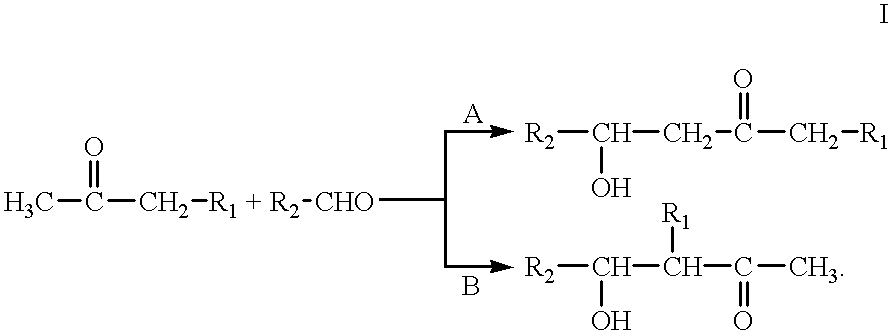Process for preparing saturated alcohols
a saturated alcohol and process technology, applied in the field of saturated alcohol preparation, can solve the problems of large amount of alkali metal passing into the wastewater, large amount of alkali contamination, etc., and achieve the effect of no selectivity improvemen
- Summary
- Abstract
- Description
- Claims
- Application Information
AI Technical Summary
Problems solved by technology
Method used
Image
Examples
example 2
Preparation of 7-n-propyl-2-methyl-4-dodecanol
From separate reservoirs, 62.5 g of 40% strength sodium hydroxide solution and a mixture of 265.5 g of methyl isobutyl ketone (2.65 mol) and 390.0 g of 2-n-propylheptanal (2.50 mol) were introduced dropwise into a 1 liter round-bottom flask over a period of 90 minutes while stirring well. The mixture was then subsequently heated to 108-110.degree. C. and stirred for 4 hours. After the reaction was complete, the mixture was allowed to cool. According to gas-chromatographic analysis, the organic phase (621.9 g) had the following composition:
Based on the 2-propylheptanal used, the yield of 7-n-propyl-2-methyldodec-5-en-4-one was 73.3% of theory.
The product was hydrogenated at a temperature of 120.degree. C. and a pressure of 10 MPa in the presence of an Ni catalyst .TM.CelActiv Ni 52 / 35. The 7-n-propyl-2-methyl-4-dodecanol was obtained in pure form by final distillation at 170.degree. C. and a pressure of 50 mbar.
example 3
Preparation of 2,7-dimethyl-4-nonanol
From separate reservoirs, 62.5 g of 40% strength sodium hydroxide solution and a mixture of 265.5 g of methyl isobutyl ketone (2.65 mol) and 215.0 g of 2-methylbutanal (2.50 mol) were introduced dropwise into a 1 liter round-bottom flask over a period of 90 minutes while stirring well. The mixture was then heated to 90.degree. C. and stirred for 4 hours. After the reaction was complete, the mixture was allowed to cool. According to gas-chromatographic analysis, the organic phase (438.5 g) had the following composition:
Based on the 2-methylundecanal used, the yield of 2,7-dimethylnon-5-en-4-one was 76.4% of theory.
The product was hydrogenated at a temperature of 120.degree. C. and a pressure of 10 MPa in the presence of an Ni catalyst .TM.CelActiv Ni 52 / 35. The 2,7-dimethyl-4-nonanol was obtained in pure form by final distillation at 127.degree. C. and a pressure of 50 mbar.
example 4
Preparation of 2,7-dimethyl-4-hexadecanol
From separate reservoirs, 31.3 g of 40% strength sodium hydroxide solution and a mixture of 132.8 g of methyl isobutyl ketone (1.33 mol) and 230.4 g of 2-methylundecanal (1.25 mol) were introduced dropwise into a 1 liter round-bottom flask over a period of 90 minutes while mixing well. The mixture was then heated to 112-118.degree. C. and stirred for 4 hours. After the reaction was complete, the mixture was allowed to cool. According to gas-chromatographic analysis, the organic phase (621.9 g) had the following composition:
Based on the 2-methylundecanal used, the yield of 2,7-dimethylhexadec-5-en-4-one was 78.0% of theory.
The product was hydrogenated at a temperature of 120.degree. C. and a pressure of 10 MPa in the presence of an Ni catalyst .TM.CelActiv Ni 52 / 35. The 2,7-dimethyl-4-hexadecanol was obtained in pure form by final distillation at 221.degree. C. and a pressure of 50 mbar.
PUM
| Property | Measurement | Unit |
|---|---|---|
| temperature | aaaaa | aaaaa |
| temperature | aaaaa | aaaaa |
| temperature | aaaaa | aaaaa |
Abstract
Description
Claims
Application Information
 Login to View More
Login to View More - R&D
- Intellectual Property
- Life Sciences
- Materials
- Tech Scout
- Unparalleled Data Quality
- Higher Quality Content
- 60% Fewer Hallucinations
Browse by: Latest US Patents, China's latest patents, Technical Efficacy Thesaurus, Application Domain, Technology Topic, Popular Technical Reports.
© 2025 PatSnap. All rights reserved.Legal|Privacy policy|Modern Slavery Act Transparency Statement|Sitemap|About US| Contact US: help@patsnap.com

